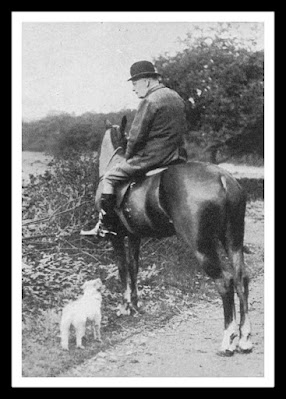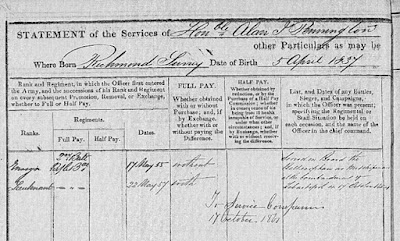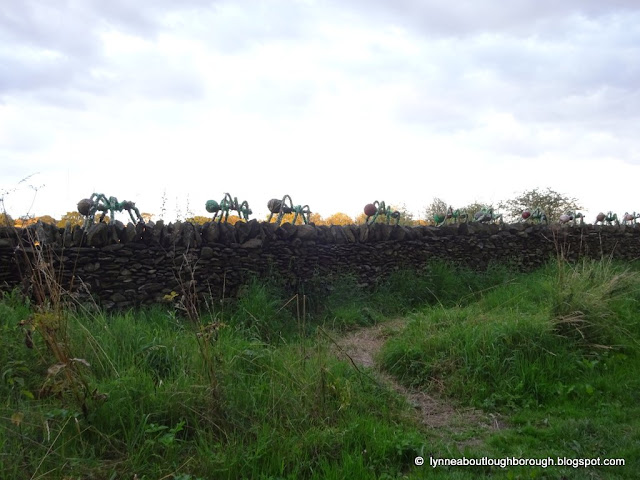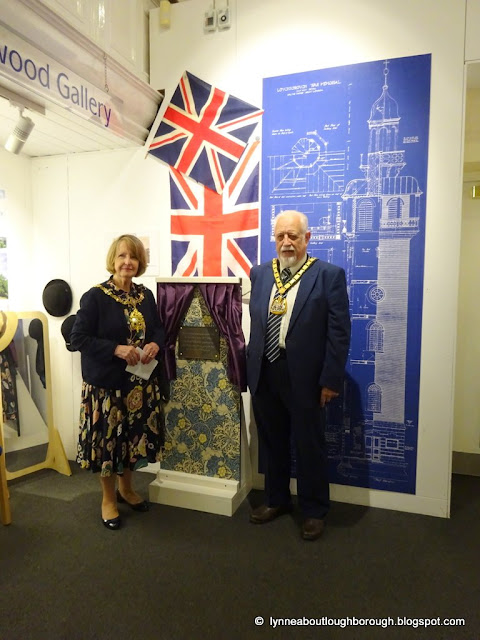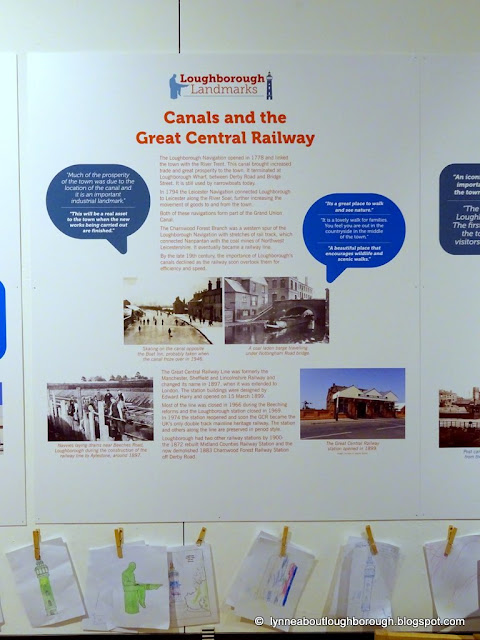Last week we looked into the earlier part of the life of the Honourable Alan Joseph Pennington, and today we pick up the story where we left off in 1880, when Alan was living in Billesdon ...
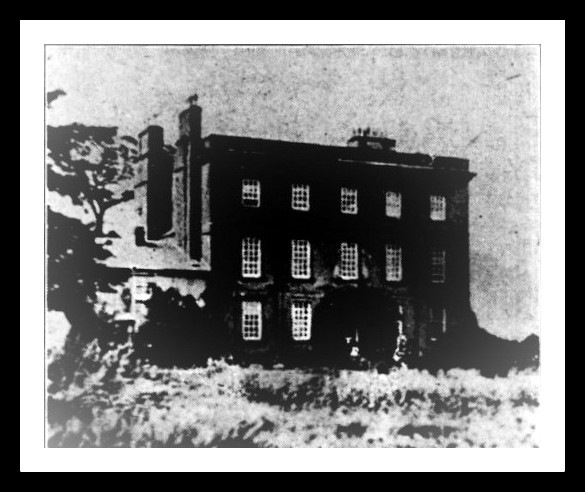 |
| Burleigh Hall, Loughborough, pictured around 1920 |
On 1st December 1880, Alan Joseph Pennington married Anna Eleonora Hartopp at the new parish of St Michael, Chester Square, London, whilst he was living at White Hall in Billesdon, and she was of the new parish, and daughter or Edward Bourchier Hartopp, and Honoria Gent, of Dalby Hall. It was the Rev. T. Hinde, vicar of Little Dalby, who performed the marriage ceremony.
On 16th December 1880, when Alan and his new wife returned from honeymoon to the White Hall in Billesdon, they found it had been beautifully decorated with evergreens and banners, and all the village inhabitants lined the streets to welcome the happy couple home. Alan had provided a sumptuous dinner for his 40-50 tradesmen and servants at the White Hart Inn, where they were served by the host Mrs Bishop. He also provided beer and tobacco to the men of the workhouse, and tea, cake, oranges, and sweets to the women and children, and gave more than 100 families 5 cwt. of coal.
 |
| White Hall, Billesdon, viewed from the side, August 2023 |
 |
| The former White Hart Inn, Billesdon, left |
However, the Penningtons very soon left White Hall in Billesdon, and in September 1881 sold off some of their furniture, carpets, kitchen equipment, and two timber huts.
The 1881 census return shows Alan Pennington, aged 44, of independent means, with wife Anna, aged 40, at what is described as the Park Grounds of Dalby Hall. There are being visited by Charles J. Fletcher, aged 37, and a magistrate with independent means, and Helen Fletcher aged 30. There are numerous servants listed: Eliza Stevenson aged 60 is the housekeeper; Anne Stevenson is the cook; Fanny Folley and Anne Ellson are Lady’s maids; Sarah A. Freer is the kitchen maid; Harriet Amis, and Jane E. Hatch are the house maids; Harriet Smith is the stillroom maid; Emma Smith is the scullery maid; James Boulger is the butler; William Sharp is the stud groom; Henry Griffiths is the valet, and John McCall the footman.
 |
| Census return |
Meanwhile, Josslyn, Alan’s older brother, the 5th Baron Muncaster, was MP for the Egremont Division of Cumberland (he owned about 15,000 acres and minerals in Lancashire), from 1885-1892.
After this, Alan’s place of residence and land-owning starts to get a bit confusing! On the electoral rolls for 1885-1887, Alan Pennington is eligible to vote on account of him occupying Dalby Parva Hall [1]. But, in 1888 he is eligible to vote on account of him occupying Ragdale Hall with Pickwell Manor, and in a separate register, Pickwell Manor, Oakham.
By the time of the 1891 census returns, Alan Pennington is getting closer to Loughborough, so aged 53, is living with his wife Anna, aged 49 (who was born in Dalby Hall), at Ragdale New Hall. Visiting the Penningtons are J.C.D. Whitmore, aged 51; Louisa M.E. Whitmore, aged 21; Ethel M. A. Whitmore aged 20, and the honourable Henry C. Butler. Servants listed on the census return are Sarah H. Reading, housekeeper; Agness McDowell, lady’s maid; James Duval, butler; Dora Bishanter, Emma Baker, Mary Sywell, and Emma Tailby, all maidservants; William Capp, footman, and Edmund Morrison, servant.
 |
| Census return |
So, we know that Alan Pennington took part in many hunts over the years (as indeed, did his wife, who we know was hunting with The Belvoir in 1881), and many of these hunts were recorded in the press of the day. Here’s just one of those newspaper reports, from the ‘Lincolnshire Chronicle’, 9th November 1894, page 5:
“THE QUORN HOUNDS.
Five hundred ladies and gentlemen in the saddle, and a procession of carriages over a mile in length, attended the opening of the hunting season with the celebrated Quorn Hounds at Kirby Gate, Leicestershire, on Monday morning. Lord Lonsdale, the master, was very cordially greeted by a brilliant assemblage. The morning was fine, and the gathering was an exceptionally distinguished one, amongst those who assembled to welcome Lord Lonsdale being Prince Henry of Pless, the Duke of Marlborough, Lady Cardigan, the Duchess of Hamilton, Lord and Lady Crawshaw [whose family seat was at Whatton House], Lord Edward Manners [eldest son of the 7th Duke of Ritland of Belvoir castle], Lady Gerard, Count and Countess Zborowski, Lord and Lady Churchill, Lord and Lady Seymour, Sir Robert and Lady Affleck, Lord Morton, Mr C. and Lady Augusta Fane, Mr Lancelot Lowther, Baron Max De Tuyll, Lady Henrietta Turnor, Lord Herbert Vane Tempest, Lord Cholmondeley, the Hon. Henry Bourke, Lord Cecil Manners, the Hon. Alan Pennington, and Mrs Asquith. Contrary to the usual custom, Lord Lonsdale first gave the order for Cream Gorse [2], and it was a long time before a fox was found, but at last one made play for Ashby Pastures and Thorpe Trussell [3], where the hounds threw up their heads. Another fox was found in Burrough Hill spinnies, and afforded and enjoyable spin.”
Electoral rolls for 1897-1898 show that Alan Pennington was eligible to vote on account of him occupying Ragdale Hall. And he is clearly closely associated with the Quorn Hunt as in 1899 he and his wife contributed towards a presentation (of a cheque) in response to the resignation of one Tom Firr, a popular huntsman with the Quorn who was suffering with ill-health. The presentation was made at the kennels in Quorn. [4]
The 1901 census returns show Alan Pennington aged 63, is living at Ragdale Hall with his wife Anna who is now aged 59, and with his niece. They have nine servants: Henry Ralph is the butler; Frederick Britt is the footman; Thomas Watson is the hall boy; Thomas Nibloe is the under-gardener; Mary Timms is the housekeeper; Emily Peel is the lady's maid; Emma Whittock (or Whitlock) is the scullery maid; Evelyn Bradbury is the kitchen maid, and Charlotte Asken is the house maid. The nearby groom's house is occupied by Austin Edmonds, the stud groom, his wife, Alice, and their baby son William, along with Walter Thompson the coachman, and the grooms, Edward Artis, William Harpham, and Charles Pollard. The nearby Ragdale Lodge is farmed by the Biddles family.
Brother, Josslyn on the same census return is living with wife, Constance at St Martin-in-the-Fields. In November of 1901, Mrs Anna Pennington was actually connected to Loughborough when some of her work was on show at the annual exhibition of the Leicestershire Ladies’ Needlework Guild, in the lecture room at the Town Hall, as had the Duchess of Somerset, Lady Crawshaw, Lady Percy St. Maur, Lady Alice Packe, Lady Agnes de Trafford and many others.
And finally, the connection with Loughborough is cemented!! According to the ‘Midland Mail’ of 12th July 1902, “the Hon. Alan Pennington has taken Burleigh Hall, Loughborough, a picturesquely situated seat...", and the move to Burleigh was certainly confirmed in the November issue of ‘The Sportsman’.
However, it seems that the Pennington’s still owned Ragdale Hall as Alan Pennington was eligible to vote on account of him occupying Ragdale. This was in 1903, when Alan was described as being one of the oldest Quornites, who hunts from the Loughborough side of the country, with Lord Crawshaw of Whatton Hall. Moving in certain circles, when the squire of Lockington’s son died in late December 1904, Alan and his wife Anna attended the funeral.
In February 1905 Alan was elected a member of the Unionist Free Trade Club, a move which was approved at a meeting of its Executive Committee. During the following years, the Penningtons regularly take up residence at 14 Lowndes Square, something which is newsworthy so reported in the newspapers! And from 1906-1913, Alan Pennington was registered to vote on account of him occupying Burleigh Hall in Loughborough, Leicestershire. His coachman at Burleigh in 1907 was someone called James Bunker. Meanwhile, in 1909, brother Josslyn, Lord Muncaster, was appointed to the Colonelcy of the Border Regiment of the Territorial Forces. He has no children, so the title and estates will pass to Alan Pennington, if he should survive his brother.
Also in 1909, Alan Pennington subscribed to a book which included an entry for both him and his wife. This was ‘British Hunts and Huntsmen’, which appeared in four volumes, and was published by the Biographical Press. Mrs Pennington was described as having
“always hunted with the best packs in the Midlands, and is known as a straight rider to hounds and an accomplished horsewoman.”
Alan Pennington was described thus:
“Early experiences in the hunting field were with the Holderness when a boy, and later in life he became Master of that pack, during the season 1877-78. Since the sixties he has been a regular follower of the Quorn, Cottesmore, Mr Tailby’s and the Belvoir, with the exception of a year in Ireland, which he devoted chiefly to the Meath and Kildare… Mr Pennington is a member of the Army and Navy Club, and resides at Burleigh Hall, Loughborough, Leicestershire, his town house being 14, Lowndes Square, S.W.”
We don’t hear much about Mrs Anna Pennington, although it is reported in the local newspapers that she regularly donates journals and other things to the local dispensary. However, we do learn from the Pennington’s activities, in this case sending a wreath to the funeral of Lady Mount-Edgcumbe, that they referred to themselves as ‘Alan and Annie of Burleigh Hall, Loughborough’.
The 1911 census returns show Alan Pennington now aged 73, and living at Burleigh Hall with wife Anna, now 69. Their visitors the night the census were Edith Henare Pilley aged 40, and John A. Cecil Pilley aged 42, who is a senior clerk in the Foreign Office. There are numerous servants: Charles Morrell, the butler; Herbert Howard the footman; Norah Webb, the cook; Elery Ferguson is the lady’s maid; Mabel Rasbough and Doris Dyston are the house maids; Margaret Dask is the kitchen maid; Mary Ellen Griffin is the stillroom maid, and Cecily Frost is the scullery maid. [NB These names are a little difficult to decipher, so they might be inaccurate].
 |
| 1911 census returns |
There are other properties on the Burleigh Estate, and these are listed separately on the 1911 census. Living at the Burleigh Lodge is Walter Maurice William Garrick with his family. Then there are two separate entries for the Burleigh Hall Stables, one listing the occupier as W. Henry Barrett, the other as Rowland George: both are grooms. In the Gardener's Cottage we find gardener George Pawlett, with his wife and young son, and also with gardener Fred Jarvis. The estate was a reasonably large one to manage, and many staff were needed to support the Pennington's. However, the coachman, Austin Edmonds, and his family - wife, Alice Edith, sons William (aged 10) and Leonard (aged 6), and daughters Ethel (aged 8) and Dorothy (aged 4) - were living at 42 Paget Street. Austin Edmonds had previously been living at Ragdale and working as the stud groom.
We return to Alan Pennington, who after residing at Burleigh Hall for just over 10 years, died on 14th June 1913. He was noted in documentation as being of Burleigh Hall in Loughborough, Leicestershire, but died at his town residence of 14 Lowndes Square. Probate was granted on 30 July 1913, to his widow Anna Eleonora (nee Hartopp), and Charles John Huskinson, solicitor, of Newark on Trent. Effects were £73,775 16s. 10d., which was resworn to £75,097 16s. 8d. It was reported in the ‘Melton Mowbray Mercury and Oakham and Uppingham News’ of 31 July 1913 that Alan Pennington bequeathed £500 to the Leicester Infirmary.
Alan
Pennington was buried on 19th June 1913, in St James’ Church, Little Dalby, and
inside the church is a bronze memorial tablet, which says:
“In loving memory of Alan Joseph Pennington, 3rd son of the 3rd Lord Muncaster. Born April 5th 1837. Died June 14th 1913, aged 76, he served his Queen in the Royal Navy, in the Bellerophon at the Siege of Sebastopol and afterwards in the Rifle Brigade. His body rests in the adjoining churchyard. I know that my redeemer liveth.”
There is also a marble tablet on a slate backboard, on the north wall of the quire in St Michael’s Church in Muncaster (Ravenglass in the Lake District, close to Muncaster Castle), which reads:
“Sacred to the memory of Alan Joseph Pennington, 3rd son of Lowther Augustus Lord Muncaster, born 1837, died 1913. He served in the Navy at the Siege of Sebastopol, 1854, and afterwards in the Rifle Brigade.”
By August
1913, Mrs Anna Pennington had decided to leave Burleigh Hall, and was arranging
a sale of furniture through German and German. The auction takes place on Tuesday
9th September and Wednesday 10th September in the King’s Head, where Mr Rayment
provides tea and luncheon.
Up for auction were highly decorative antique and superior modern furnishing, including bedroom suites, carpets, Sheraton and Chippendale furniture, bedsteads, gilt mirrors, and much more, some of which is detailed in the advert below, from the Loughborough Echo of 5th September 1913:
 |
| Some of the items from Burleigh Hall for auction 1913 |
On 30th March 1917, Josslyn Frances, 5th Baron Muncaster died. Probate was granted to Sir John Frecheville Ramsden, baronet, and a relative of his mother’s. Rosslyn was listed as being of Muncaster Castle, Ravenglass, Carnford. Effects were £8,187 15s. 3d. He expressed a desire that whomever succeeded to Muncaster Castle, would take the Muncaster family surname of Pennington. As his brother, Alan had pre-deceased him, and neither of them had any children, it is not clear who Muncaster Castle passed to.
Only three months after the death of her husband, in July 1917, Constance A. Pennington, aged 77, wife of Josslyn Frances Pennington, died, the death being registered at Bootle. She had suffered a long illness. Bizarrely, her death happened on the day the will of her husband was proved.
On 13 July 1921, Gamel’s widow, died. She had re-married, between 1861 and 1871, such that in 1871 she was living with Hugh Barlow Lindsey on Albermarle Street, Mayfair, but died at Dinoin Portpatrick Wigtownshire. He was born in Calcutta and had retired from the Indian Civil Service, while she had been born in Motcombe, Dorset, and was styled Lady Lindsey.
On 5th
December 1934 Anna Eleanor Pennington, wife of Alan, died. She was of 21
Princes Gardens, Middlesex. Probate was granted on 14 February to Henry
Beauclerk Howe, and bank agent, and John Brownlow Norman, a solicitor. Effects
were 34,968 3s. 2d. resworn to £33,543 6s. 3d.
As I said in Part 1, I do not know who inherited the estates left by the Pennington family, as there were no direct descendants. I do however know who took on Burleigh Hall after Mrs Pennington left, but that story is for another time!
____________________________________
[1] Dalby Parva is today known as Little Dalby
[2] Cream Gorse is an area between Gaddesby and Great Dalby (once known as Dalby Magna)
[3] Thorpe Trussell is close to Thorpe Satchville
[4] You can read a detailed report of this presentation on the Quorn Village Museum website
___________________________________
Posted by lynneaboutloughborough
With apologies for typos which are all mine!
_______________________________________________
Thank you for reading this blog.
Copyright:
The copyright © of all content on this blog rests with me, however, you are welcome to quote passages from any of my posts, with appropriate credit. The correct citation for this looks as follows:
Dyer, Lynne (2023). The Right Honourable Alan Joseph Pennington of Burleigh Hall, Loughborough Part 2. Available from: https://lynneaboutloughborough.blogspot.com/2023/09/the-right-hon-alan-joseph-pennington-of.html [Accessed 17 August 2023]
Take down policy:
I post no pictures that are not my own, unless I have express permission so to do. All text is my own, and not copied from any other information sources, printed or electronic, unless identified and credited as such. If you find I have posted something in contravention of these statements, or if there are photographs of you which you would prefer not to be here, please contact me at the address listed on the About Me page, and I will remove these.
Blog archive and tags:
If you are viewing this blog in mobile format, you will not be able to easily access the blog archive, or the clickable links to various topics. These can be accessed if you scroll to the bottom of the page, and click 'View Web Version'. Alternatively, there is also a complete list of posts, which when clicked will take you to the page you are interested in.
Searching the blog:
You can search the blog using the dedicated search box that appears near the top of the blog when viewed in the web version. Alternatively, you can search using your usual search engine (e.g. Bing, Google, DuckDuckGo etc.) by following this example:
site: https://lynneaboutloughborough.blogspot.com/ “Radmoor House”
NOTE – the words you’re actually looking for must be in “” and the first of these must be preceded by a space
Thank you for reading this blog.
Lynne

